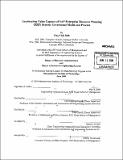Accelerating value capture of SAP enterprise resource planning (ERP) system : governance model and process
Author(s)
Shih, Ting-Chih
DownloadFull printable version (41.71Mb)
Alternative title
Accelerating value capture of SAP ERP system : governance model and process
Accelerating value capture of System Analysis and Program Development enterprise resource planning system : governance model and process
Other Contributors
Leaders for Manufacturing Program.
Advisor
Deborah Nightingale and John Carroll.
Terms of use
Metadata
Show full item recordAbstract
Raytheon produces a diverse range of defense products using a wide range of business systems and tools that are not currently integrated. To achieve the corporate vision of "one company", in 2005, Raytheon began to deploy its SAP enterprise resource planning (ERP) system, called "PRISM", focused on planning, sourcing, manufacturing, and delivery processes. After a few single-site PRISM deployments, in 2009, Raytheon launched its biggest deployment yet, to 7,000 users and two business units in California and Texas. This thesis explores effective governance models and post-deployment governance processes necessary to mitigate the anticipated performance dip and accelerate return on investment (ROI) of the SAP system. The desired governance model for multi-business unit SAP ERP system includes comprehensive representation of stakeholders from business functional areas, information technology (IT) areas, user support groups, and SAP system experts. The governance structure consists of integration points among users, system experts, process owners, management, and corporate leadership team to ensure development of corporate system and solutions to address business unit needs. The governance process involves reviewing change requests, assessing changes needed, and deciding on final resolution. The governance structure and its linkages among different groups facilitate the process by involving the stakeholders with the appropriate knowledge and experience to contribute to decision making. The result is a governance structure capable of making just-in-time decisions to implement the "one-company" vision.
Description
Thesis (M.B.A.)--Massachusetts Institute of Technology, Sloan School of Management; and, (S.M.)--Massachusetts Institute of Technology, Engineering Systems Division; in conjunction with the Leaders for Manufacturing Program at MIT, 2009. Includes bibliographical references (p. 114-115).
Date issued
2009Department
Leaders for Manufacturing Program at MIT; Massachusetts Institute of Technology. Engineering Systems Division; Sloan School of ManagementPublisher
Massachusetts Institute of Technology
Keywords
Sloan School of Management., Engineering Systems Division., Leaders for Manufacturing Program.